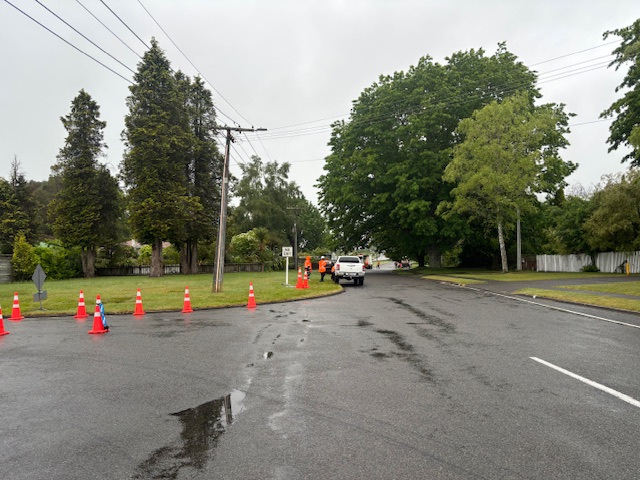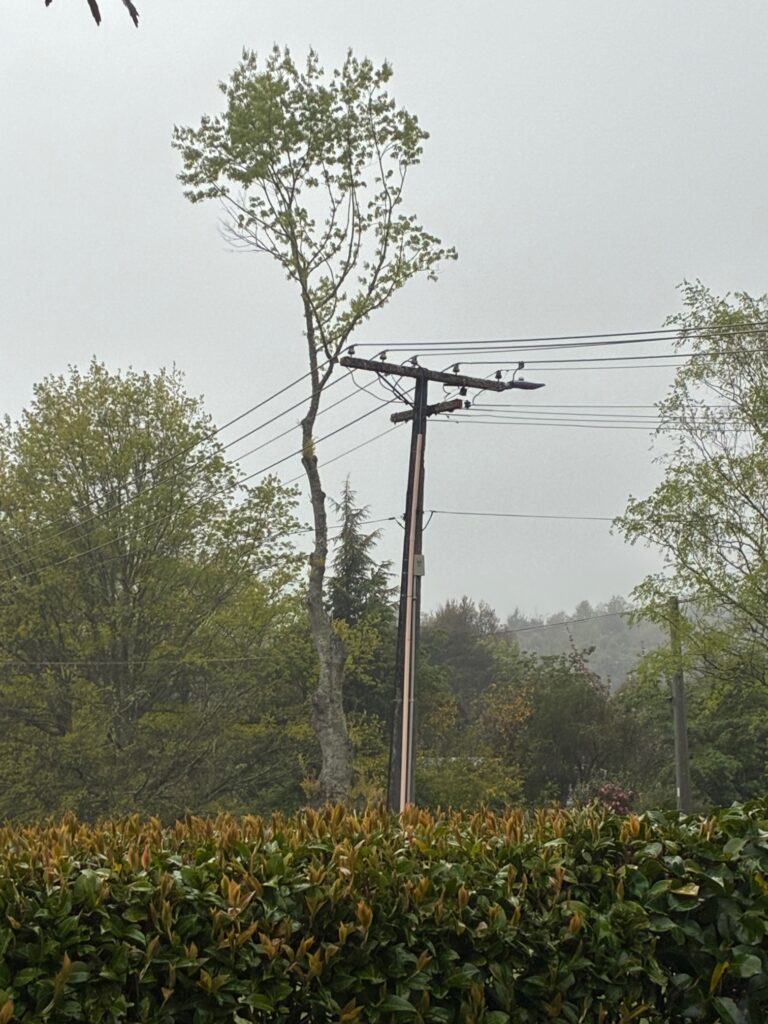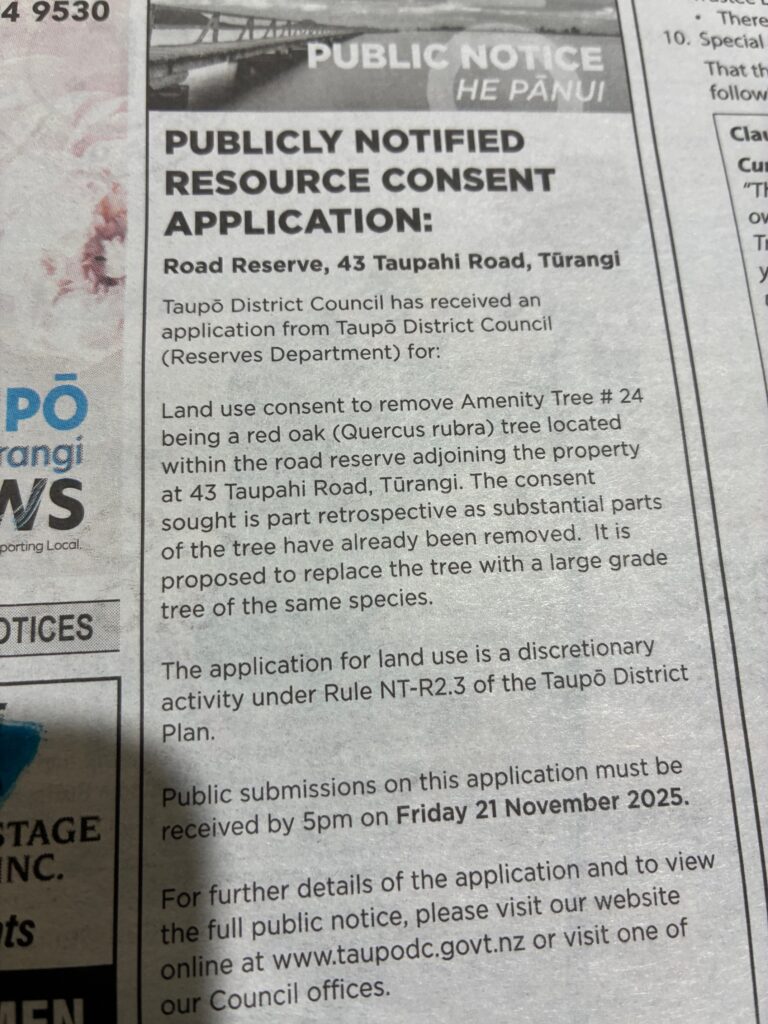
Photo above of the original execution day on 14 November 2024.
It has been almost one year since the Toe Paw butchers skilfully pruned the protected Red Oak tree that graced the northern end of Taupahi Road. They thought they had effectively killed it but history has proven Oak trees have remarkable restorative powers. See the photo below taken in the wet conditions today from my living room today.

Instead of giving up and dying, the Red Oak has rebounded with healthy spring growth. Obviously, it will recover. So now, Toe Paw wallies have advertised – Page 30 in Taupo & Turangi Times – a “PUBLICLY NOTIFIED RESOURCE CONSENT APPLICATION” to remove the tree. Why? Note, they admit their disgrace by advising, “The consent is part retrospective as substantial parts of the tree have already been removed.” What an absolute cock-up by the council!
Now the tree is visibly recovering, shocked local residents are still asking why? Where is the Council’s explanation of why it was butchered almost one year ago? Where is the arborist’s report? The residents and regular tourist visitors (who own holiday homes in Turangi) suggest it should be left to survive as a leafy monument, to remind rate payers of the stupidity of Toe Paw Council.

Since posting the above resource consent application, we discovered the council’s apology and explanation dated about six months ago.
Warning – it may need a cup of tea to get to the bitter end… For anyone considering making a submission, it does include Council’s analysis of options.
Tūrangi Co-Governance Committee Meeting Agenda 12 February 2025
5.4 TAUPAHI ROAD – REQUEST FOR TREE REMOVAL
Author: Authorised by: Billie Vi, Parks Advisor – Planning and Operations
Greg Hadley, Parks and Reserves Manager
TE PŪTAKE | PURPOSE
To consider the removal of a Red Oak (Quercus rubra) tree located on Taupahi Road, Tūrangi.
WHAKARĀPOPOTOTANGA MATUA | EXECUTIVE SUMMARY
Resource Consent RM160403 permits Council staff to programme on-going maintenance and remedial work on various protected trees across the district, this includes notable and amenity trees.
The work requested by parks operation staff was to prune the Red Oak tree outside 43 Taupahi Road, Tūrangi to remedy encroachment of the tree onto neighbouring properties. The work was carried out on 14 November 2024 by Council contractors. However, instead of maintenance work, the tree was disassembled for removal.
Because this is an amenity tree and the partial removal has resulted in the Red Oak tree’s current state, council officers seek a recommendation from the Tūrangi Co-Governance Committee.
Council’s consultant arborist, Adrian Lamont from Dendrology Limited was the successful applicant when Council went out for expressions of interest for an arboricultural assessor. Council has a panel of qualified arborists for tree works, however, Adrian is an independent contractor utilised for tree assessments before any tree work commences. Adrian provides the level of expertise that is necessary for tree assessments.
This includes the required qualification to assess the structural integrity of a tree and impartiality. monitors notable and amenity trees across the district and has a history with the Red Oak that was partially removed.
NGĀ TŪTOHUNGA | RECOMMENDATION(S)
That the Tūrangi Co-Governance Committee agree to remove the Red Oak (Quercus rubra) outside number 43 – 47 Taupahi Road, Tūrangi, subject to a resource consent obtained by council officers.
TE WHAKAMAHUKI | BACKGROUND
The proposal has not been presented previously.
The owner of house number 43 Taupahi Road, Tūrangi requested a pruning of the tree to reduce encroachment over their boundary. Under the resource consent RM160403, Council is permitted to carry out on-going maintenance and remedial work on various protected trees, including this Red Oak. The work was started on 14 November 2024. However, instead of pruning the tree, the contractor commenced removal of the tree. Before ceasing work, they had removed the entire branch structure, with only the central most stem and a small fraction of its original foliar cover. Once Council was notified of the extent of the work being carried out, an immediate order to ‘cease all work’ was issued.
Following a site inspection a memo report was obtained from Council’s consultant arborist, Adrian Lamont from Dendrology Limited. This report is attached (note, this is not the usual assessment under the Tree and Vegetation Policy 2014).
An independent investigation into what occurred is still ongoing.
NGĀ KŌRERORERO | DISCUSSION
Council’s arborist has assessed the tree and reported on its current state.
The tree is listed as an amenity tree under Council’s District Plan. The parks team holds a resource consent to maintain trees listed in the District Plan that are on Council reserve. This consent does not cover removal of any notable or amenity tree.
As outlined in the arborist’s report, “Prior to the partial felling of the tree it was in good health, with full, lush foliar cover. There will be a significant amount of stored energy in the remaining stem and roots and at least in the short term, there is very likely to be a flush of dense new epicormic growth arising from the wound. This is when the new shoots arise from dormant buds, triggered by a hormonal response to damage, stress or increased light exposure.
In its current state the tree has lost all its aesthetic appeal and has minimal remaining value as a landscape feature or specimen tree. The species is known for its full, broadly spreading canopy and this specimen has been reduced to a single narrow, vertical stem with minimal foliage remaining. Furthermore, any new growth is likely to be held close the main stem and the tree will continue to have a highly unnatural appearance for decades to come.
In the short term, the remaining stem is at an increased risk of failure due to the radical change in shelter and crown balance and the loss of any damping effect from lateral branches and foliage and will not be well adapted to being left fully exposed.
In the long term, there is very likely to be significant decay ingress via the numerous large wounds that have been created up the stem. Combined with dense new epicormic growth and the additional weight and wind drag, this will further increase the risk of stem failure.”
Council’s Tree and Vegetation Policy 2014, policy 3.1 allows for the removal of unhealthy trees where the opinion of a qualified arborist that the tree meets the following criteria. While the tree was in a healthy state prior to the work being carried out, in the opinion of Council officers, Policy 3.1 is applicable.
NGĀ KŌWHIRINGA | OPTIONS
Analysis of Options
There are three possible options.
Option 1. Leave the tree in its existing condition.
Advantages Disadvantages
• No further work required other than managing the epicormic growth.
• Potential for main stem failure.
• High probability of stem decay.
• Unnatural form with little aesthetic appeal.
Option 2. Reduce to the bole (approximately 3 metres above ground).
Advantages Disadvantages
• The tree remains in a safer form, removing the potential danger outlined in the arborist’s report.
• There is little remaining branch structure.
• The tree would not regain its original structure.
• Indefinite maintenance would be required for the life of the tree to manage epicormic growth and would forever be of limited amenity value.
Option 3. Removal of the tree and replacement specimen tree planted.
Advantages Disadvantages
• Opportunity for a new tree to be planted which • Cost of Resource Consent, tree removal and
Item 5.4 Page 11Tūrangi Co-Governance Committee Meeting Agenda 12 February 2025 would fit better within the existing streetscape.
• Opportunity to replace with a more suitable species (the Red Oak achieved a size that caused issues for both infrastructure and neighbouring properties.)
• Council would be following the advice received by Council’s consultant arborist, that the tree in its present form is potentially dangerous. stump grinding.
Analysis Conclusion:
The preferred alternative is Option 3 as recommended by Council’s consultant arborist. Due to the work carried out on the tree it is now potentially dangerous (mitigated by Options 2 and 3) but is now in particularly poor form and detracts rather than adds amenity to Taupahi Road.
NGĀ HĪRAUNGA | CONSIDERATIONS
Ngā Aronga Pūtea | Financial Considerations
No cost has been incurred by Council to date.
Depending on the committee’s decision and pending the recommendation of the investigation, the cost could range from $1,000 (estimate) for maintenance to make safe to $10,000 (estimate) for a resource consent, Traffic Management Plan (TMP), removal. If the tree was to be retained there would be ongoing annual maintenance required (as per the arborist report).
Ngā Aronga Ture | Legal Considerations
Local Government Act 2002
The matter comes within scope of the Council’s lawful powers, including satisfying the purpose statement of Section 10 of the Local Government Act 2002. That section of the Act states that the purpose of local government is (a) to enable democratic local decision-making and action by, and on behalf of, communities; and (b) to promote the social, economic, environmental, and cultural well-being of communities in the present and for the future. It is considered that environmental and social factors are of relevance to this particular matter.
The proposal has been evaluated with regards to a range of legislation. The key legislation applicable to the proposal has been reviewed and the relevant matters for consideration are as follows:
Authorisations as follows are required for the proposal:
Resource Consent ☐ Building Consent ☐ Environmental Health
☐ Liquor Licencing ☐ Licence to occupy
The current resource consent RM160403 permits Council the on-going maintenance and remedial works on various protected trees. The programmed work conducted on 14 November 2024 was permitted under this resource consent.
If the Tūrangi Co-Governance team agree to removal and replacement of the tree, then a resource consent is required because RM160403 does not permit the removal of a protected tree, this includes amenity trees.
Resource Consent RM160403
This resource consent permits the on-going maintenance and remedial works on various protected trees across the district. This consent does not permit the remove of protected trees; therefore, a resource consent is required.
Resource Consent required
The work actioned by Council officers for pruning of the tree on Taupahi Road, Tūrangi was permitted under the resource consent mentioned above, RM160403. However, to remove this amenity tree and to cover the work that has been already done on the tree, a new resource consent is required. RM160403 does not permit the removal of protected trees or the extent to which this tree was pruned.
Item 5.4 Page 12Tūrangi Co-Governance Committee Meeting Agenda 12 February 2025
Ngā Hīraunga Kaupapa Here | Policy Implications
The proposal has been evaluated against the following plans:
☐ Long Term Plan 2024-2034 ☐Annual Plan ☐ Waikato Regional Plan
Taupō District Plan ☐ Bylaws ☐ Relevant Management Plan(s)
Taupō District Plan
3p.3.2 Objective is to identify and provide a level of protection for amenity trees.
The objective is to maintain the level of amenity provided by these trees, ensuring the effects of any alteration or removal can be avoided. It also allows Council to ensure the health, vigour and function of amenity trees are not compromised by any development or other activity. This also provides for the ongoing care and maintenance of amenity trees across the district.
Te Kōrero tahi ki te Māori | Māori Engagement
Taupō District Council is committed to meeting its statutory Tiriti O Waitangi obligations and acknowledges partnership as the basis of Te Tiriti. Council has a responsibility to act reasonably and in good faith to reflect the partnership relationship, and to give effect to the principles of Te Tiriti. These principles include, but are not limited to the protection of Māori rights, enabling Māori participation in Council processes and having rangatiratanga over tāonga.
Our statutory obligations outline our duties to engage with Māori and enable participation in Council processes. Alongside this, we recognise the need to work side by side with iwi, and hapū of our district.
Ngā Tūraru | Risks
There are known risks as outlined in the arborist report. If the tree were to remain there is potential for the likes of stem decay or stem failure. Further, if it were to remain, there is a reputational risk to Council from the ongoing cost of maintaining a tree that will never achieve good structural form. Therefore, the most viable and safe option for the Tūrangi community is to remove the tree and replant with a suitable specimen.
TE HIRANGA O TE WHAKATAU, TE TONO RĀNEI | SIGNIFICANCE OF THE DECISION OR PROPOSAL
Council’s Significance and Engagement Policy identifies matters to be taken into account when assessing the degree of significance of proposals and decisions.
Officers have undertaken an assessment of the matters in the Significance and Engagement Policy (2022), and are of the opinion that the proposal under consideration is of a low degree of significance.
TE KŌRERO TAHI | ENGAGEMENT
Taking into consideration the above assessment, that the decision is of a low degree of significance, officers are of the opinion that no further engagement is required prior to Council making a decision.
TE WHAKAWHITI KŌRERO PĀPAHO | COMMUNICATION/MEDIA
No communication or media posts have been organised with the communication team following the outcome of this report. Communications can be organised following direction from the Committee.
WHAKAKAPINGA | CONCLUSION
Based on the information within this report, Council officers recommend to remove the tree, stump grind and replace with a suitable specimen tree after seeking the appropriate resource consents in order for this work
to be done.
NGĀ TĀPIRIHANGA | ATTACHMENTS
1. Arborist report of Taupahi Road tree, Tūrangi.
Item 5.4 Page 13
